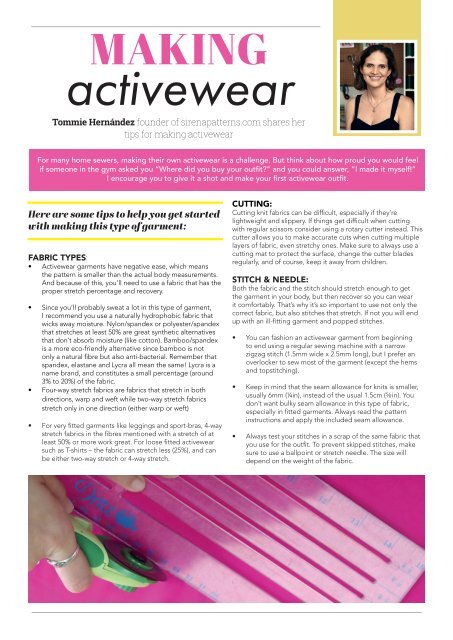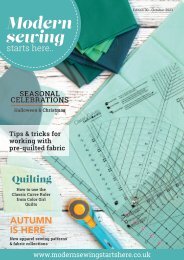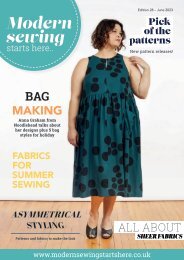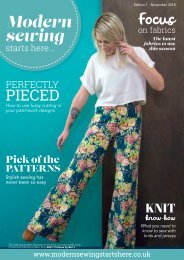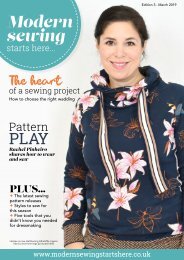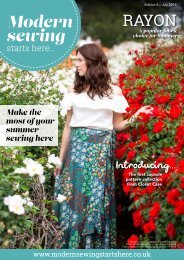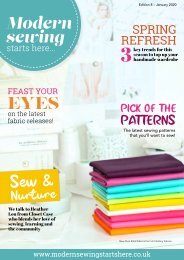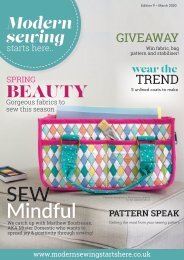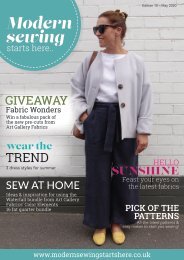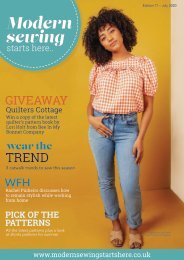Modern Sewing Starts Here Edition 15
Modern Sewing Starts Here is the digital publication which features articles, reviews and handy tips for anyone with an interest in contemporary sewing In this edition ... Pick Of The Patterns .... New sewing pattern releases that you’ll want to sew! Brazilian-born sewing blogger, Rachel Pinheiro shares her go-to style that she turns to most days! Tips for making activewear with Tommi Hernandez. We talk to Bari J. artist, author, designer and home décor expert about her instantly recognisable floral style! Julie Bonnar from The Pattern Pages shares her tips on making sure your garment is the perfect fit! Sarah Ashford, obsessive quilter and fabric lover shares her sewing with the Serenity fabric collection from Art Gallery Fabrics. Trendsetter ... Three of the best jacket makes for Spring. Focus On Fabrics... + More ...
Modern Sewing Starts Here is the digital publication which features articles, reviews and handy tips for anyone with an interest in contemporary sewing
In this edition ...
Pick Of The Patterns .... New sewing pattern releases that you’ll want to sew!
Brazilian-born sewing blogger, Rachel Pinheiro shares her go-to style that she turns to most days!
Tips for making activewear with Tommi Hernandez.
We talk to Bari J. artist, author, designer and home décor expert about her instantly recognisable floral style!
Julie Bonnar from The Pattern Pages shares her tips on making sure your garment is the perfect fit!
Sarah Ashford, obsessive quilter and fabric lover shares her sewing with the Serenity fabric collection from Art Gallery Fabrics.
Trendsetter ... Three of the best jacket makes for Spring.
Focus On Fabrics...
+ More ...
Create successful ePaper yourself
Turn your PDF publications into a flip-book with our unique Google optimized e-Paper software.
MAKING<br />
activewear<br />
Tommie Hernández founder of sirenapatterns.com shares her<br />
tips for making activewear<br />
For many home sewers, making their own activewear is a challenge. But think about how proud you would feel<br />
if someone in the gym asked you “Where did you buy your outfit?” and you could answer, “I made it myself!”<br />
I encourage you to give it a shot and make your first activewear outfit.<br />
<strong>Here</strong> are some tips to help you get started<br />
with making this type of garment:<br />
FABRIC TYPES:<br />
• Activewear garments have negative ease, which means<br />
the pattern is smaller than the actual body measurements.<br />
And because of this, you’ll need to use a fabric that has the<br />
proper stretch percentage and recovery.<br />
• Since you’ll probably sweat a lot in this type of garment,<br />
I recommend you use a naturally hydrophobic fabric that<br />
wicks away moisture. Nylon/spandex or polyester/spandex<br />
that stretches at least 50% are great synthetic alternatives<br />
that don’t absorb moisture (like cotton). Bamboo/spandex<br />
is a more eco-friendly alternative since bamboo is not<br />
only a natural fibre but also anti-bacterial. Remember that<br />
spandex, elastane and Lycra all mean the same! Lycra is a<br />
name brand, and constitutes a small percentage (around<br />
3% to 20%) of the fabric.<br />
• Four-way stretch fabrics are fabrics that stretch in both<br />
directions, warp and weft while two-way stretch fabrics<br />
stretch only in one direction (either warp or weft)<br />
• For very fitted garments like leggings and sport-bras, 4-way<br />
stretch fabrics in the fibres mentioned with a stretch of at<br />
least 50% or more work great. For loose fitted activewear<br />
such as T-shirts – the fabric can stretch less (25%), and can<br />
be either two-way stretch or 4-way stretch.<br />
CUTTING:<br />
Cutting knit fabrics can be difficult, especially if they’re<br />
lightweight and slippery. If things get difficult when cutting<br />
with regular scissors consider using a rotary cutter instead. This<br />
cutter allows you to make accurate cuts when cutting multiple<br />
layers of fabric, even stretchy ones. Make sure to always use a<br />
cutting mat to protect the surface, change the cutter blades<br />
regularly, and of course, keep it away from children.<br />
STITCH & NEEDLE:<br />
Both the fabric and the stitch should stretch enough to get<br />
the garment in your body, but then recover so you can wear<br />
it comfortably. That’s why it’s so important to use not only the<br />
correct fabric, but also stitches that stretch. If not you will end<br />
up with an ill-fitting garment and popped stitches.<br />
• You can fashion an activewear garment from beginning<br />
to end using a regular sewing machine with a narrow<br />
zigzag stitch (1.5mm wide x 2.5mm long), but I prefer an<br />
overlocker to sew most of the garment (except the hems<br />
and topstitching).<br />
• Keep in mind that the seam allowance for knits is smaller,<br />
usually 6mm (¼in), instead of the usual 1.5cm (5/8in). You<br />
don’t want bulky seam allowance in this type of fabric,<br />
especially in fitted garments. Always read the pattern<br />
instructions and apply the included seam allowance.<br />
• Always test your stitches in a scrap of the same fabric that<br />
you use for the outfit. To prevent skipped stitches, make<br />
sure to use a ballpoint or stretch needle. The size will<br />
depend on the weight of the fabric.


